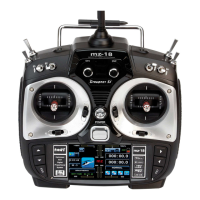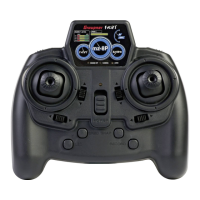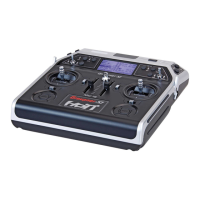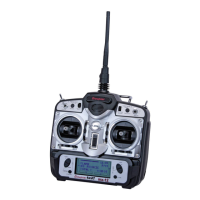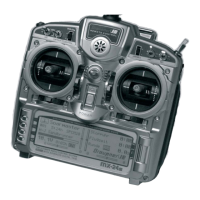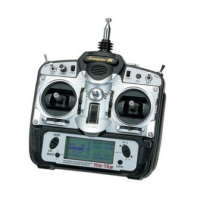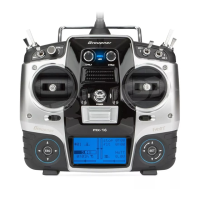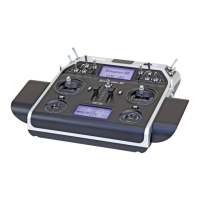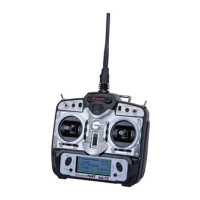Definition of Terms
Control, Control Channel, Control Function, Control Switch, Function Input, Logical Switch, Mixer,
Switch
The following definitions appear repeatedly in this
manual:
Controls
Controls are the control elements on the transmitter
that are activated directly by the pilot that control the
connected servos, speed controllers, etc. on the re-
ceiver. These include:
• The two control sticks for control functions 1
- 4, including the related trims. These four func-
tions in all the six model types (vehicle, boat,
drone, helicopter, airplane and glider) can be
exchanged using the Mode Setting in the soft-
ware. For example: throttle/brake or throttle/
pitch left or right. The control stick function for
throttle/brake flap control for fixed-wing mod-
els or throttle/pitch control in helicopters is usu-
ally identified as the THR Control (channel 1).
• The four proportional dials (DV1 - DV4)The two
side proportional rotary controls SL1 and SL2.
• Switches S1 - S8
• The INC/DEC buttons DT1 and DT2
With the DV and SL proportional controls, as well as
the DT buttons, the servos directly follow the control
position, whereas only a two or three-stage adjust-
ment is possible with a switch.
The assignment of controls and switches to servos 5
-12 is freely programmable.
Control Channel
The term "control channel" is used to describe the
point at which a signal contains all control information
necessary for a particular servo, whether directly from
the control or indirectly via a mixer.
For example, the "aileron" control function of a fixed-
wing model for the model type 2AILE is divided into
control channels for the left and right aileron. Anal-
ogously, the"roll" control functionfor the helicopter
model 3S 120(Roll) governs the controlchannels for
both the left and right roll servo.
This signal is influenced by settings made in the fol-
lowing BASE submenus: E.P.A (servo path/servo lim-
it), REV/SUB (servo direction reverse/delay and servo
middle and neutral position), and Out.Swap (trans-
mitter output). The signal is then transmitted by the
transmitter through the RF module. Once it arrives in
the receiver, this signal may be modified by settings
saved in the FUNCTION submenu Telemetry. The
signal then controls the associated servo.
Control Function
A control function is the signal for a specific control
function, independent from the signal within the trans-
mitter. For example, in fixed-wing models the control
signals would be throttle, rudder or aileron; in helicop-
ter models these would be pitch, roll or nick.
The control function signal can be transmitted directly
into a single control channel, or through a mixer to
several control channels. A typical example of the lat-
ter are separate aileron servos, or the use of two roll
or elevation servos in helicopters. The control function
includes the influence of the mechanical control path
on the corresponding servo. This can be spread or
concentrated and modified from linear to highly ex-
ponential.
Control Switch
It is oftentimes impractical to automatically switch
a timer or a function on or off when a control is in
a specific position (e.g. a stopwatch turns on/off to
measure engine operating times). The mz-24 Pro
HoTT transmitter allows control switches to be pro-
grammed.
With these programmed switches, users identify the
switching point along the control path in the direction
of switching. Refer to the Controls and Switches As-
signment (page 26) for additional information.
Function Input
This is an imaginary point in the signal flow and should
not be confused with the control connection on the
printed circuit board. The selected Control Mode and
the TX OUT SET setting of the BASE submenu TX ctl
influence the sequence beyond the physical connect-
ing points. This generates differences between the
number of function inputs and the number of subse-
quent control channels.
Logical Switch
This option allows two switches, controls and/or log-
ical switches (or the preferred combination thereof)
to be interconnected into a single AND/OR switch.
A total of 8 logical switches, L1 - L8, can be pro-
grammed. Refer to the FUNCTION submenu Logi-
cal sw section (page 148) for additional information.
Mixer
The transmitter program contains a variety of mixing
functions. These allow a control function to influence
several control channels to control several servos or
allow several control functions to influence a single
servo.
Refer to the Basic Functions section (page 132) for
additional information on mixers.
Switch
The series of toggle switches S1 - S8 can be used in
control programming, to change program options (i.e.
timer start/stop), to turn mixers on and off, as trainer
switches etc. Each switch can be assigned any num-
ber of functions.
Related examples are described throughout the man-
ual.
24 Definition of terms
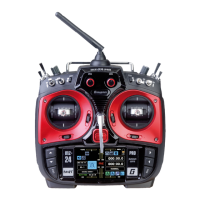
